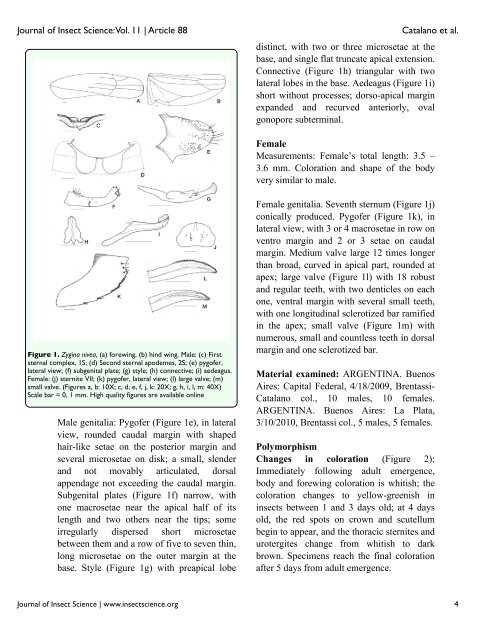Download free PDF - Journal of Insect Science
Download free PDF - Journal of Insect Science
Download free PDF - Journal of Insect Science
You also want an ePaper? Increase the reach of your titles
YUMPU automatically turns print PDFs into web optimized ePapers that Google loves.
<strong>Journal</strong> <strong>of</strong> <strong>Insect</strong> <strong>Science</strong>: Vol. 11 | Article 88<br />
Catalano et al.<br />
distinct, with two or three microsetae at the<br />
base, and single flat truncate apical extension.<br />
Connective (Figure 1h) triangular with two<br />
lateral lobes in the base. Aedeagus (Figure 1i)<br />
short without processes; dorso-apical margin<br />
expanded and recurved anteriorly, oval<br />
gonopore subterminal.<br />
Female<br />
Measurements: Female’s total length: 3.5 –<br />
3.6 mm. Coloration and shape <strong>of</strong> the body<br />
very similar to male.<br />
Figure 1. Zygina nivea, (a) forewing, (b) hind wing. Male: (c) First<br />
sternal complex, 1S; (d) Second sternal apodemes, 2S; (e) pyg<strong>of</strong>er,<br />
lateral view; (f) subgenital plate; (g) style; (h) connective; (i) aedeagus.<br />
Female: (j) sternite VII; (k) pyg<strong>of</strong>er, lateral view; (l) large valve; (m)<br />
small valve. (Figures a, b: 10X; c, d, e, f, j, k: 20X; g, h, i, l, m: 40X)<br />
Scale bar = 0, 1 mm. High quality figures are available online<br />
Male genitalia: Pyg<strong>of</strong>er (Figure 1e), in lateral<br />
view, rounded caudal margin with shaped<br />
hair-like setae on the posterior margin and<br />
several microsetae on disk; a small, slender<br />
and not movably articulated, dorsal<br />
appendage not exceeding the caudal margin.<br />
Subgenital plates (Figure 1f) narrow, with<br />
one macrosetae near the apical half <strong>of</strong> its<br />
length and two others near the tips; some<br />
irregularly dispersed short microsetae<br />
between them and a row <strong>of</strong> five to seven thin,<br />
long microsetae on the outer margin at the<br />
base. Style (Figure 1g) with preapical lobe<br />
Female genitalia. Seventh sternum (Figure 1j)<br />
conically produced. Pyg<strong>of</strong>er (Figure 1k), in<br />
lateral view, with 3 or 4 macrosetae in row on<br />
ventro margin and 2 or 3 setae on caudal<br />
margin. Medium valve large 12 times longer<br />
than broad, curved in apical part, rounded at<br />
apex; large valve (Figure 1l) with 18 robust<br />
and regular teeth, with two denticles on each<br />
one, ventral margin with several small teeth,<br />
with one longitudinal sclerotized bar ramified<br />
in the apex; small valve (Figure 1m) with<br />
numerous, small and countless teeth in dorsal<br />
margin and one sclerotized bar.<br />
Material examined: ARGENTINA. Buenos<br />
Aires: Capital Federal, 4/18/2009, Brentassi-<br />
Catalano col., 10 males, 10 females.<br />
ARGENTINA. Buenos Aires: La Plata,<br />
3/10/2010, Brentassi col., 5 males, 5 females.<br />
Polymorphism<br />
Changes in coloration (Figure 2):<br />
Immediately following adult emergence,<br />
body and forewing coloration is whitish; the<br />
coloration changes to yellow-greenish in<br />
insects between 1 and 3 days old; at 4 days<br />
old, the red spots on crown and scutellum<br />
begin to appear, and the thoracic sternites and<br />
urotergites change from whitish to dark<br />
brown. Specimens reach the final coloration<br />
after 5 days from adult emergence.<br />
<strong>Journal</strong> <strong>of</strong> <strong>Insect</strong> <strong>Science</strong> | www.insectscience.org 4
















